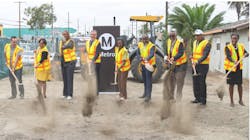L.A. Metro holds groundbreaking for Rail to Rail path for walkers, cyclists, rollers in Inglewood and South Los Angeles
A groundbreaking was held by the Los Angeles County Metropolitan Transportation Authority (L.A. Metro) for the Rail to Rail project, a new 5.5-mile path for pedestrians, cyclists and rollers that will transform a blighted, unused rail corridor in Inglewood and South Los Angeles and connect to several L.A. Metro bus and rail lines.
“This project perfectly encapsulates Metro’s vision and commitment to mobility that goes beyond buses and trains,” said Eric Garcetti, Los Angeles mayor and L.A. Metro Board member. “By converting an abandoned and blighted railway into a world class bike and pedestrian path, we are providing significant quality of life and mobility improvements to some of Los Angeles’ most under-served neighborhoods — providing safe options for the student who bikes to school, or the family setting out for a walk.”
The $143-million project is a significant investment in the Inglewood and South L.A. community and will inject new life and vibrancy into a historically disadvantaged area. The path is expected to be completed in 2024.
The path will connect the future K Line’s (Crenshaw/LAX) Fairview Heights Station, the Metro J Line’s (Silver) Slauson Station and the A Line (Blue) Slauson Station. Path amenities will include extensive landscaping, including several hundred shade trees, lights, security cameras, street furniture and wayfinding signage, among other features.
The path will be constructed along the former Harbor Subdivision — the route of an old freight railroad — and will improve access to the neighborhood communities of Hyde Park, Chesterfield Square, Harvard Park, Vermont-Slauson, South Park and Central-Alameda.
“I could not be happier to see this important active transportation project break ground,” said L.A. Metro CEO Stephanie Wiggins. “The Rail to Rail project will improve on a well-worn path thousands of people in the community used every day, improving access to transit and adding beautiful amenities to the community in the process. Thank you to the Metro Board, the city of L.A., our federal and state partners and everyone else who worked so hard to bring this project to the people of South L.A.”
L.A. Metro is now studying a second phase of the project called “Rail to River” that will extend the path eastward to the Los Angeles River.
The latest census data shows that this corridor has some of L.A. County’s highest percentages of people who rely on transit, biking and walking to commute. Nearly 19 percent of households in the area do not have access to a car. Census data also indicates that nearly 4,300 pedestrians and 2,500 cyclists use the corridor each day. Rail to Rail will provide a safety benefit for bicyclists and pedestrians because the new path will be mostly separated from busy local streets.
Adding to new transit options in the area, L.A. Metro anticipates opening the 8.5-mile K Line light-rail project later this year. The K Line will extend from E Line (Expo) at Expo/Crenshaw Station and merge with C Line (Green) at Aviation/LAX Station, connecting the Crenshaw Corridor, Inglewood and El Segundo.
Rail to Rail was funded through a variety of local, state and federal sources, including a federal TIGER grant, Transportation Development Act funds, proceeds from L.A. Metro’s 2008 Measure R sales tax, L.A. County’s Measure W Safe and Clean Water Grant, L.A. County Repurposed Earmark, the State Active Transportation Program Grant and a CalSTA Soil Mitigation Grant.
The city of Los Angeles also requested significant public right-of-way improvements be completed in conjunction with the project and contributed $30 million to pay for these improvements. The city’s funding will bring ADA and pedestrian accessibility improvements to 22 intersections along the Rail to Rail route and will increase pedestrian visibility and reduce vehicle/pedestrian interactions.
